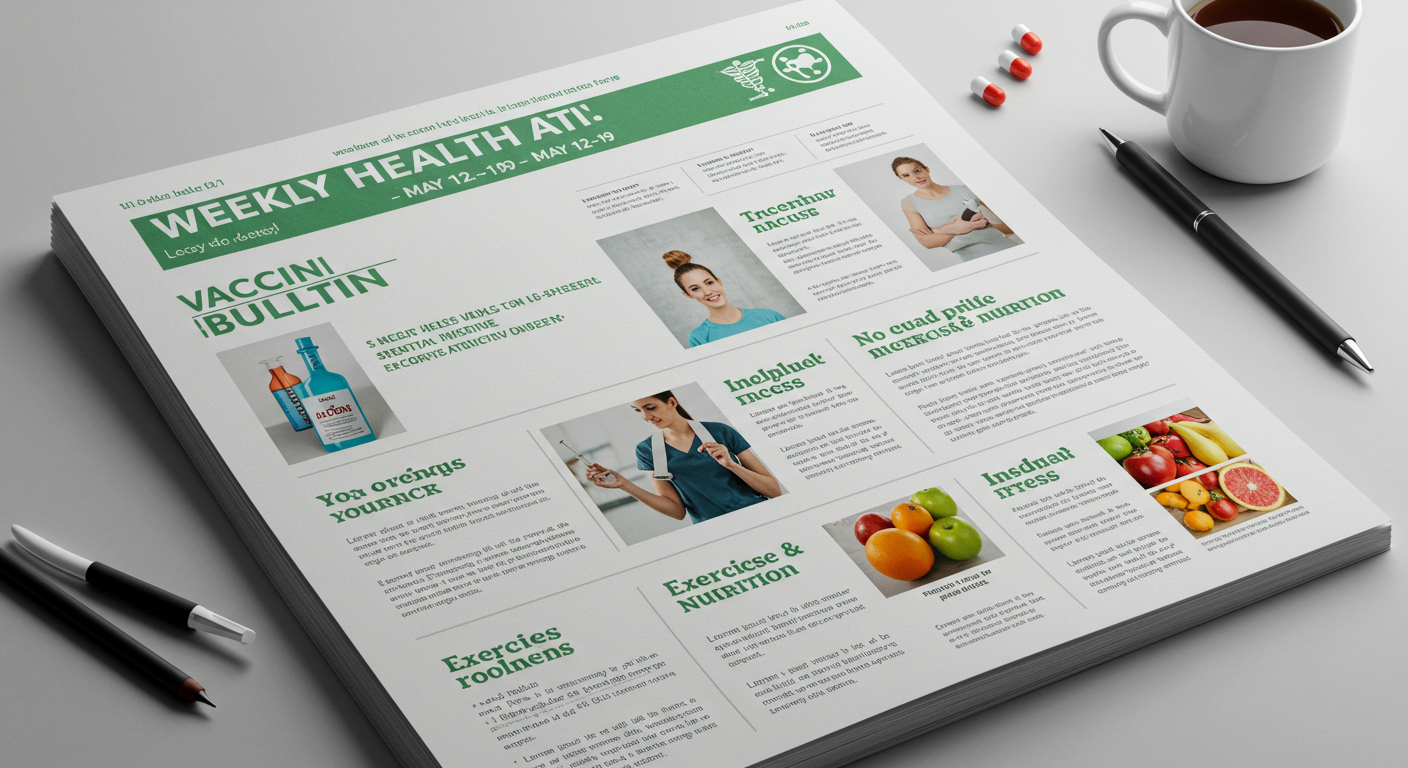
Infectious Diseases and Vaccination
WHO reports an alarming measles resurgence in the Americas: 2,318 cases (Apr 2025), an 11-fold jump from 2024, including 1,069 cases in Canada. Most cases are in unvaccinated youth and young adults, prompting WHO to assess the regional measles risk as high (global risk moderate) and to urge full MMR vaccination for all susceptible individuals. Public health officials warn that falling immunization rates could reverse decades of progress; travelers and communities are strongly encouraged to verify two-dose measles vaccination before exposure. In related vaccine news, the U.S. FDA has fully approved Novavax’s COVID-19 vaccine – but only for select groups (adults ≥ 65 or ages 12–64 with certain health risks). This limited approval (distinct from Pfizer/Moderna approvals for all eligible people) signals that health authorities view protein-based Novavax as a seasonal option for high-risk populations. (The FDA also asked Novavax for more safety data in healthy younger adults, reflecting caution in broadening approval.)
Mental Health and Well-being
A new Leger survey (Apr 2025) highlights a widening Canadian mental health gap. It found that 63% of Canadians report experiencing at least one mental health symptom (stress, anxiety, etc.), with young adults hardest hit (74% of ages 18–34). Yet only about 36% have ever received a formal diagnosis, meaning many struggle without proper support. Those who have been diagnosed are more likely to report health improvements, but the data show many waited years for diagnosis. The findings underscore urgent needs for earlier screening, better awareness and more accessible, affordable care. In youth services, McGill-led researchers report striking gains by redesigning care pathways. The ACCESS Open Minds initiative lets young people self-refer and aims for evaluation in 3 days (treatment by 30 days). Over four years and ~8,000 youth served, most were seen within the 3-day target (vs typical waits of 45+ days), and referrals climbed 10% every semester. Even community clinics for marginalized youth (e.g. in Montreal) doubled access with just two extra staff. These results suggest that relatively small resource boosts and service reforms can dramatically speed up care for vulnerable youth, improving outcomes by connecting them to help sooner. Mental Health and Well-being Updates: Prioritizing Your Inner Peace
Mental health is an integral component of overall well-being, and this week’s news highlights the ongoing efforts to address mental health challenges and promote positive mental health practices.
The State of Mental Health Globally
New guidance from the World Health Organization (WHO) calls for an urgent transformation of mental health policies worldwide, emphasizing the need to address underfunding and significant gaps in access and quality of care. Globally, mental disorders account for a substantial portion of years lived with disability, and people with severe mental health conditions face significantly shorter lifespans. In the United States, a significant number of adults experience mental illness, with a large percentage not receiving the necessary treatment.

Factors Influencing Mental Health
Research continues to explore the various factors that can impact mental health. Studies have found that combinations of chronic illnesses can significantly increase the risk of depression. Interestingly, the gut microbiome is also being investigated for its role in psychological resilience, revealing a gut-brain stress connection. Neighborhood stress has been linked to potential impacts on children’s brains, potentially increasing their risk of depression. Furthermore, feelings of sadness or hopelessness are increasingly reported among adolescents, underscoring the need for continued support and intervention for this age group.
Innovations in Mental Health Care
Technology is playing an increasingly transformative role in mental health care delivery, making support more accessible and tailored to individual needs. Technology-driven approaches, including digital tools and teletherapy, offer novel pathways for implementing evidence-based treatments. Even non-invasive brain stimulation techniques are showing promise in significantly reducing symptoms of depression, anxiety, and PTSD. It’s crucial to foster healthy social-emotional development from an early age, as it lays the foundation for children’s long-term physical and mental health.
Seeking Support and Promoting Well-being
It’s essential to recognize the signs of mental health challenges and seek support when needed. Various organizations offer resources and support for individuals struggling with mental health conditions. Creating supportive environments and promoting open conversations about mental health are vital steps in destigmatizing mental illness and ensuring that everyone has access to the care they deserve.
Gut Health and Microbiome Research
Emerging studies continue to link gut microbes with serious health outcomes. For example, a global study published in Nature (Apr 2025) implicates a bacterial toxin, colibactin, in early-onset colorectal cancer. Researchers analyzed tumor DNA from ~1,000 patients and found that cancers in adults under 40 were 3–5 times more likely than those in seniors to carry mutations characteristic of past colibactin exposure. This suggests childhood colonization by certain E. coli strains may seed mutations that later fuel cancer. Diet’s impact on the microbiome is also underscored by new animal data. University of Chicago scientists report that mice on a Western-style diet (highly processed, low fiber) failed to rebuild a healthy gut microbiome after antibiotic treatment, whereas mice fed a Mediterranean-like (plant-rich) diet rapidly restored microbial diversity. In other words, high-fiber, whole-food diets appeared to bolster microbiome resilience post-antibiotics, while junk-food diets prolonged dysbiosis and infection risk. Finally, a Nature-based global analysis forecasts a steep rise in inflammatory bowel disease (IBD) in Canada by 2045. This model (using a century of data and machine learning) categorizes countries’ IBD stages; it shows that Canada’s prevalence is poised to climb markedly, alerting policymakers to prepare healthcare services for more Crohn’s and ulcerative colitis cases.
Exercise and Fitness
New studies underscore that even very brief workouts and regular activity pay off. For instance, a May 2025 report highlights a small trial in which sedentary adults did a daily five-minute strength routine (squats, pushups, sit-ups, etc.) for four weeks. This tiny program significantly improved participants’ physical fitness and mental well-being. The key factor was consistency: even such short, progressive exercises “can offer untold perks” for beginners by accumulating health benefits. In complementary findings, UT Southwestern researchers found that lifelong high activity levels may slow brain aging. Very active adults showed less brain volume loss over time, suggesting exercise has neuroprotective effects. Together these insights reinforce that both short daily workouts and periodic vigorous exercise (even just 1–2 days per week) can boost fitness and mental health.
Nutrition and Lifestyle
Recent nutrition research highlights diet quality as a key determinant of long-term health. A large Canadian study (May 2025) shows that ultra-processed foods (UPFs) trigger inflammation independently of weight. Adults consuming the most UPFs (packaged snacks, sugary drinks, etc.) had significantly higher C-reactive protein and white blood cell counts – markers of systemic inflammation – even after adjusting for BMI and lifestyle. The authors suggest our bodies may treat UPFs as “non-foods,” provoking immune responses. These unhealthy diets were common across all socioeconomic groups, underscoring the need for policies to reduce UPF exposure. On the other hand, long-term cohort data affirm that whole-food diets promote healthy aging. A landmark 30-year Harvard study tracked >100,000 people and found that higher midlife diet quality (rich in fruits, vegetables and whole grains) strongly predicted healthier aging. Those with better diets had lower rates of chronic disease and preserved cognitive/physical function later in life. In sum, evidence increasingly shows that swapping ultra-processed items for nutritious, plant-rich foods can boost physical health, reduce inflammation, and improve quality of life as we age.

Advances in Wearable Health Technology: Monitoring Your Well-being in Real-Time
Wearable technology has revolutionized how we track and manage our health, offering unprecedented access to real-time data and personalized insights.
The Expanding Capabilities of Wearable Devices
The market for wearable healthcare devices is experiencing significant growth, projected to reach nearly $70 billion by 2028. This reflects the increasing consumer interest in real-time self-monitoring of health and wellness. Wearable devices now go beyond basic step counting, offering advanced features such as heart rate monitoring, sleep tracking, stress monitoring, and even blood oxygen saturation measurements. Smartwatches equipped with electrocardiogram (ECG) capabilities can aid in early detection of potential heart issues. A significant breakthrough in the field is the development of self-healing electronic skin that can repair itself in seconds, potentially transforming personal health monitoring by ensuring durability and reliability. This technology can recover over 80% of its functionality within 10 seconds of being damaged.
Integrating Wearables into Healthcare
The integration of wearable devices with telehealth and electronic health records (EHRs) holds immense promise for enhancing healthcare delivery. Pilot programs have demonstrated improved outcomes in managing conditions like hypertension through personalized health coaching combined with wearable-generated data. Wearables can facilitate remote patient monitoring, allowing healthcare professionals to track patients’ health metrics in real-time and intervene proactively. The use of open application programming interfaces (APIs) enables seamless data sharing between devices and healthcare systems. Partnerships between healthcare systems and technology companies are leveraging wearables for remote patient monitoring and chronic disease management.

Future Directions in Wearable Technology
The future of wearable technology is brimming with innovation. Advances in biosensors, artificial intelligence (AI), and machine learning are paving the way for even more sophisticated health monitoring. We can expect to see the development of hybrid wearable-implantable systems that combine external monitoring with internal precision for comprehensive health surveillance. Sensor-embedded smart fabrics that continuously monitor vital signs and movements offer non-intrusive health tracking. Even augmented reality (AR) glasses could display real-time health data directly in the user’s field of vision. AI-driven predictive analytics will anticipate health issues before they escalate, empowering proactive interventions. While challenges such as data privacy and equitable access need to be addressed, the potential of wearable technology to empower individuals in managing their health is undeniable.
Sources: Compiled from recent global and Canadian news and research reports published May 12–19, 2025. All specific findings and quotes are cited above.
Sources:
- WHO, Measles – Region of the Americas, 18 Apr 2025 Organização Mundial da Saúde
- ReliefWeb, Disease Outbreak News: Measles, Region of the Americas, 28 Apr 2025 ReliefWeb
- CDC, Measles — United States, Jan 1–Apr 17, 2025, MMWR CDC
- New York Post, Washington Traveler Measles Case, 15 May 2025 New York Post
- Houston Chronicle, Texas Measles Update, 16 May 2025 Houston Chronicle
- KFF, Tracking Poll on Measles Awareness, Apr 2025 KFF
- Nature, Colibactin and Early-Onset Colorectal Cancer, Apr 2025 Global Biodefense
- PAHO, Immunization Gaps in the Americas, Apr 2025 OPAS
- AAP News, 2025 Measles Outbreaks, May 2025 Publicações AAP
- Harvard Study on Diet and Aging, 2025
- McGill University, ACCESS Open Minds Initiative, 2025






